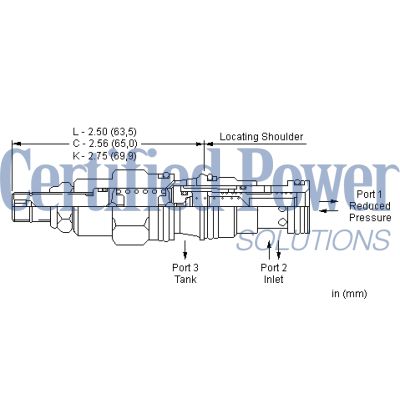SUN HYDRAULICS
PPDFKPV
- SUN HYDRAULICS
- Material:PPDFKPV
- Model:PPDF-KPV
- Summary:Cartridge
Due to extremely high demand, please call 888-905-7411 for availability
***Disclaimer: The following summary contains information gathered from various sources such as product descriptions, technical specifications and catalogs. While efforts have been made to provide accurate details, inaccuracies may occur. It is advised to verify all information by contacting Sun Hydraulics directly.***
The Sun Hydraulics PPDFKPV (Material Number: PPDFKPV) is a pilot-operated, pressure-reducing/relieving valve designed for high-performance applications. This valve reduces a high primary pressure at inlet port 2 to a constant reduced pressure at port 1 and includes a full-flow relief function from port 1 to tank port 3. The main stage orifice is drilled into the piston, enhancing durability for demanding conditions. It features a maximum operating pressure of 5000 psi (350 bar) and requires careful consideration of the maximum pressure at port 3, which should not exceed 3000 psi (210 bar). The valve exhibits stable, low-hysteresis performance with exceptionally flat pressure-flow characteristics. This model is particularly suitable for applications where pilot flow consumption is not critical, as it offers superior stability over fast dynamic response. It can handle reverse flow from reduced pressure port 1 to inlet port 2, although this may cause the main spool to close unless a separate check valve is added to the circuit. The PPDFKPV valve incorporates Sun's floating style construction that minimizes internal part binding due to excessive installation torque or cavity/cartridge machining variations. For optimal performance, the recommended maximum inlet pressure varies by adjustment range: Ranges D, E, N, and Q are tested with a maximum differential of 2000 psi (140 bar), while ranges A, B, and H allow up to 3000 psi (210 bar). Ranges C and W can handle up to 5000 psi (350 bar). The cartridge design ensures compatibility across all three-port configurations within the same frame size. With an installation torque requirement of 30-35 lbf ft (41-47 Nm) and adjustable settings via an internal hex screw or locknut mechanism, this valve provides flexibility in various hydraulic systems. Additionally, it supports factory-pressure settings established at blocked control ports for precise control in complex circuits.
The Sun Hydraulics PPDFKPV (Material Number: PPDFKPV) is a pilot-operated, pressure-reducing/relieving valve designed for high-performance applications. This valve reduces a high primary pressure at inlet port 2 to a constant reduced pressure at port 1 and includes a full-flow relief function from port 1 to tank port 3. The main stage orifice is drilled into the piston, enhancing durability for demanding conditions. It features a maximum operating pressure of 5000 psi (350 bar) and requires careful consideration of the maximum pressure at port 3, which should not exceed 3000 psi (210 bar). The valve exhibits stable, low-hysteresis performance with exceptionally flat pressure-flow characteristics. This model is particularly suitable for applications where pilot flow consumption is not critical, as it offers superior stability over fast dynamic response. It can handle reverse flow from reduced pressure port 1 to inlet port 2, although this may cause the main spool to close unless a separate check valve is added to the circuit. The PPDFKPV valve incorporates Sun's floating style construction that minimizes internal part binding due to excessive installation torque or cavity/cartridge machining variations. For optimal performance, the recommended maximum inlet pressure varies by adjustment range: Ranges D, E, N, and Q are tested with a maximum differential of 2000 psi (140 bar), while ranges A, B, and H allow up to 3000 psi (210 bar). Ranges C and W can handle up to 5000 psi (350 bar). The cartridge design ensures compatibility across all three-port configurations within the same frame size. With an installation torque requirement of 30-35 lbf ft (41-47 Nm) and adjustable settings via an internal hex screw or locknut mechanism, this valve provides flexibility in various hydraulic systems. Additionally, it supports factory-pressure settings established at blocked control ports for precise control in complex circuits.
Pilot-operated, pressure reducing/relieving valves reduce a high primary pressure at the inlet (port 2) to a constant reduced pressure at port 1, with a full-flow relief function from port 1 to tank (port 3).
- These valves have the main stage orifice drilled into the piston rather than a staked-in orifice. This allows the valve to survive physically demanding applications.
- Maximum pressure at port 3 should be limited to 3000 psi (210 bar).
- Pressure at port 3 is directly additive to the valve setting at a 1:1 ratio and should not exceed 3000 psi (210 bar).
- Pilot operated reducing, reducing/relieving valves by nature are not fast acting valves. For superior dynamic response, consider direct acting valves.
- Recommended maximum inlet pressure is determined by the adjustment range. Ranges D, E, N, and Q are tested with a 2000 psi (140 bar) maximum differential between inlet and reduced pressure. Ranges A, B, and H are tested with a 3000 psi (210 bar) maximum differential between inlet and reduced pressure. Ranges C and W are tested with 5000 psi (350 bar) of inlet pressure.
- Pilot operated valves exhibit exceptionally flat pressure/flow characteristics, are very stable and have low hysteresis.
- Full reverse flow from reduced pressure (port 1) to inlet (port 2) may cause the main spool to close. If reverse free flow is required in the circuit, consider adding a separate check valve to the circuit.
- If pilot flow consumption is critical, consider using direct acting reducing/relieving valves.
- All three-port pressure reducing and reducing/relieving cartridges are physically interchangeable (i.e. same flow path, same cavity for a given frame size). When considering mounting configurations, it is sometimes recommended that a full capacity return line (port 3) be used with reducing/relieving cartridges.
- W and Y controls (where applicable) can be specified with or without a special setting. When no special setting is specified, the valve is adjustable throughout its full range using the W or Y control. When a special setting is specified, this setting represents the maximum setting of the valve.
- Incorporates the Sun floating style construction to minimize the possibility of internal parts binding due to excessive installation torque and/or cavity/cartridge machining variations.
| Cavity | T-11A |
| Series | 1 |
| Capacity | 10 gpm40 L/min. |
| Factory Pressure Settings Established at | blocked control port (dead headed)blocked control port (dead headed) |
| Maximum Operating Pressure | 5000 psi350 bar |
| Control Pilot Flow | 7 - 10 in³/min.0,11 - 0,16 L/min. |
| Adjustment - Number of Clockwise Turns to Increase Setting | 55 |
| Valve Hex Size | 7/8 in.22,2 mm |
| Valve Installation Torque | 30 - 35 lbf ft41 - 47 Nm |
| Adjustment Screw Internal Hex Size | 5/32 in.4 mm |
| Locknut Hex Size | 9/16 in.15 mm |
| Locknut Torque | 80 - 90 lbf in.9 - 10 Nm |
| Model Weight | .30 lb0,15 kg |
| Seal kit - Cartridge | Viton: 990-011-006 |
Show FAQ
Additional Resources
- Series 4 PLUS Cartridges Offer Higher Flows with Lower Pressure Losses
- Sun Offers Zinc-Nickel Plating for Corrosion Resistance
- Sun Cartridges with EPDM Seals
- QuickDesign with SmartConnect Offers Drag-and-Drop Schematic Tool
- Sun Expands Corrosion-Resistant Solutions
- Manufacturing Sun Cartridge Cavities
- Reducing and Reducing/Relieving Valves
- Performance Data
- Sun's Floating Style Screw-In Cartridge
- Units of Measure, Settings, and Conversions
- Sun Model Code Explanation; 999-901-334
- Cavity Information (S-171) and Tooling
- Cartridges: Materials of Construction
- Fluid and Temperature Recommendations
Notes:
- For Series 1 cartridges configured with an O control (panel mount handknob), a .75 in. (19 mm) diameter hole is required in the panel.

